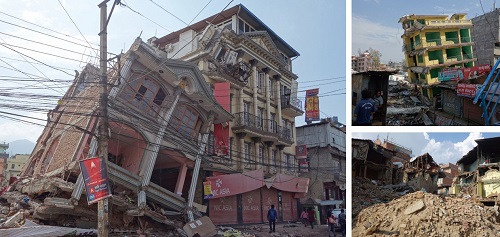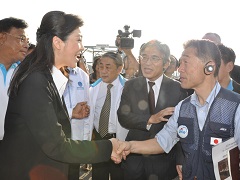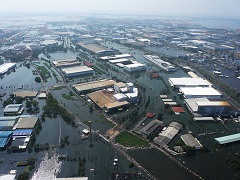Japan has experienced many earthquakes, typhoons, and other natural disasters. That experience and the knowledge acquired have been utilized in disaster risk reduction projects in developing countries. The Sendai Framework for Disaster Risk Reduction (DRR) a UN document adopted in the 3rd UN DRR Conference held in Sendai City in 2015, represents JICA's strong desire to approach disaster risk reduction projects from the two perspectives of human security and quality growth.
Disaster risk reduction initiatives as fundamental pillars of a nation's economic development and growth
The poor people in developing countries often live in areas vulnerable to disaster. They are so easily affected when a disaster occurs and fall further into poverty. This negative spiral of disaster and poverty leads to reduced national and regional capabilities and deterioration of public peace. JICA's Distinguished Technical Advisor to the President Kimio Takeya explains:
"Disaster risk reduction leads to both human security and quality growth. The Sendai Framework for DRR adds a policy of simultaneously reducing poverty while addressing disaster risk by engaging in disaster risk reduction with a focus on economic development."
Takeya, a member of the negotiating team from the Japanese government that spearheaded the development of the Sendai Framework for DRR, was also a key member during the negotiations at the preparatory discussions in Geneva, wherein he summarized the essence of disaster risk reduction.
"Based on the fact that investment in pre-disaster risk reduction is highly cost-effective and enables sustainable development, we explained that investment from a long-term perspective is more important than taking on the expensive cost of emergency response and recovery in the aftermath of a disaster."
As a simplified example, if flood control measures such as constructing levees to address major once-in-a-hundred-years flooding are implemented, disaster risk reduction investment can prevent flood damage for 100 years. During that time, the flood plain can develop economically, and even if flooding occurs, the wealth accumulated can be used for reconstruction, becoming more resilient. Such thinking is the basis for this type of investment. Disaster risk reduction investment is not limited to levees but also includes construction of typhoon-resistant facilities and earthquake-resistant roads. Takeya is a strong advocate of disaster risk reduction investment. He says, "The basic principle of the Sendai Framework for DRR is to consider disaster risk reduction as an investment for the sustainable growth of the nation. It introduces measures to reduce economic loss, not only effectively minimizing the number of deaths from disasters, but also alleviate poverty. This thinking is also consistent with multiple sustainable development goals (SDGs)." The European Union (EU) was influenced by JICA's advocacy and worked to inform public opinion ahead of its adoption of the Sendai Framework for DRR. According to them, "One euro of disaster risk reduction investment can avoid 4 to 7 euro in disaster damages and losses."
Looking ahead to the implementation of the Sendai Framework for Disaster Risk Reduction
Japan, which has created a disaster-resistant society by revising laws and standards after each large-scale disaster and allocates 5% to 8% of its annual budget to disaster reduction. On the other hand, there are many developing countries that have not been able to secure a sufficient budget for disaster risk reduction. To address this situation, JICA proposed the concept of "Build Back Better," where a more disaster-resistant society is built when disasters occur. Utilizing Japan's knowledge and experience, JICA has put together disaster risk reduction support that includes preparation of disaster statistics and data, and formulation of plans based on risk assessment.
Takeya says, "For example, in Vietnam, discussions have been held between the Minister of the Vietnam Disaster Management Authority, related government agencies, the Ministry of Finance, and JICA. They are preparing a disaster risk reduction road map in accordance with the Sendai Framework for DRR that includes studying Vietnam's disaster profile and prioritizing measures accordingly." He continues, "To realize the appropriate investment, it's necessary for the central government to make policy development its top priority together with local authorities, and for various entities, including private companies, NGOs/NPOs, international bodies, and regional networks to play their respective roles under those policies.
Government responsibility and leadership are most important by far in disaster risk reduction. As such, strengthening of governance is set forth as the second priority for action in the Sendai Framework for DRR. It's not easy, but we will continue to hold discussions with each country on the promotion and implementation of the framework."
Based on the Sendai Framework for DRR, measures have begun to be implemented by various countries in anticipation of future growth. These multi-faceted disaster risk reduction strategies also consider economic growth and anti-poverty measures in developing countries.
What is the Sendai Framework for Disaster Risk Reduction?
In 2015, more than 6,500 people participated in the World Conference on DRR held in Sendai City, Miyagi, including representatives, international bodies, researchers, and NGOs from 187 countries. In the resulting Sendai Framework for DRR 2015-2030, an agreement was reached on four priorities for action and seven targets.
[Four Priorities for Action]
- 1 . Understanding disaster risk
- 2 . Strengthening of disaster risk governance to manage disaster risk
- 3 . Investing in disaster risk reduction for resilience
- 4 . Enhancing disaster preparedness for effective response and implementing "Build Back Better" in the reconstruction and recovery process
Investing in development for risk reduction

Many buildings in Nepal's capital of Kathmandu, and other areas, collapsed as a result of the earthquake.
The case of the Nepal Earthquake
In April 2015, a magnitude 7.8 earthquake hit Nepal. It caused tremendous damage, with more than 30,000 fatalities and around 800,000 homes either partially or fully destroyed. Based on the "Build Back Better" concept, reconstruction efforts are underway not to simply restore the original condition, but also to incorporate advance investment to reduce the risk of disaster.
JICA visited the disaster area right after the incident and proposed to Nepal's Prime Minister and Finance Minister a policy based on the "Build Back Better" concept. In addition to reconstructing general housing that meets earthquake resistance standards for victims through ODA loans, work has been done to restore and improve the housing environment. JICA is also cooperating in the maintenance of social infrastructure and institutions, including reconstruction of hospitals and water supply lines and bridge maintenance. JICA is providing seamless cooperation, from emergency relief directly following disasters to full-scale reconstruction support and promoting the "Build Back Better" concept.
Aiming for Build Back Better

Then Prime Minister Yingluck of Thailand (left) and Kimio Takeya (right)

Many plants incurred flood damage as a result of flooding in Thailand in 2011.




scroll